Employee scheduling is more complex than people tend to give it credit for. Here at Celayix, we realize that. In fact, our main goal here is to make scheduling easy! Every single project we work on and feature we develop has that one goal at the center. Most of the advice out there around employee scheduling is focused on all of the things you should be doing. Here, we take a look at some of the most common employee scheduling mistakes, and how you can avoid them.

If managed incorrectly, scheduling employees can end up being a serious drain on your organization. Inefficient scheduling wastes time and money. Creating schedules takes too long and mistakes or overtime expenses can be costly. Let’s take a look at some common employee scheduling mistakes that you should avoid!
Using Overtime to fill gaps
We’ve all been there, the schedule is almost done but there are some gaps that need filling. More often than not, schedulers turn to overtime to fill these gaps. In fact, this is one of the most common employee scheduling mistakes we see with new clients.
The problem is, overtime costs you more than a regular employee shift. Generally, there is no way to get that money back. Let’s review the 2 types of overtime you typically see on a schedule:
Unbillable Overtime – this is the most common type of overtime, where employers cannot recover the costs of the overtime worked. Generally, this applies to industries like hospitality, manufacturing, retail etc.
Billable Overtime – In some scenarios, employers can bill overtime to their clients if they require extra coverage. Companies like security guard providers can generally charge overtime back to the client, allowing them to recover, some, if not all of the costs.

So, unless you can bill a client for the overtime you schedule, you should absolutely avoid it. Overtime is not only a matter of money and labor costs. Most employees resent having to work overtime, leading it to create more issues such as absenteeism, turnover, and reduced employee engagement.
Overtime is not the answer to gaps in your schedule. Take the time to revise your schedule, and make other changes before resorting to overtime. Generally, moving people or shifts around can fill those gaps better than overtime could.
Ignoring employee availability
Do you ever take your employee availability into consideration when creating your schedule? Our guess is that you don’t. Schedulers are guilty of assuming that hourly workers are available whenever they need them to be, but this isn’t always true. Remember, they do have personal lives!
Start looking at employee availability as an important factor in your scheduling process. Long gone are the days when employees have no say in the workplace, and this also applies to employee scheduling.
If possible, provide a mechanism that allows employees to input their availability a couple of weeks in advance of you working on the schedule. This means you can avoid a lot of effort further down the line, with shift swapping, missed shifts, and late check-ins. Employees will also appreciate you giving them some level of autonomy over their schedule. Attendance will improve and morale will go up across the board.
Failure to Prepare for Absences

Hourly or shift workers have some of the highest levels of absenteeism, due to the nature of their work lives. Managers are rarely prepared for these absences, which causes issues such as client/customer dissatisfaction, and lost productivity. Generally, this is one of the employee scheduling mistakes that most schedulers don’t know how to handle.
At the very least, managers should always have a standby pool on hand, with a list of reliable, qualified employees. Depending on the industry/organization, be sure to cover every role and responsibility in this stand-by pool so that you are never relying on one cog to keep the system running.
Cover all of your bases. Even better than a stand-by pool is employee scheduling software that can find replacements for you instantly based on employee availability, qualifications, and certifications. This saves time and increases the likelihood of finding a replacement for the shift.
Schedule distribution

How do you distribute your work schedule? Print it out and stick it on the notice board? Send an email on a Sunday evening before the work week starts? These are not the ideal ways to distribute your employee schedule, for a number of reasons!
Avoid displaying your schedule in one location, and expecting your staff to go see it. Yes, employees may see it and that’s great, but what happens if something changes? Can you be sure that everyone will see the changes? What if someone misreads the schedule and misses a shift?
Using a centralized, digital version of a schedule means that it can be shared directly with employees in real time, on any device. It also allows you to update the schedule and re-distribute it in a matter of minutes, and alert the necessary people to any changes affecting them. It also allows multiple people to contribute to the schedule without any changes being lost or overwritten!
Failure to Automate
Automation is one of the best things to happen to business operations, ever. Ignoring it might be one of the most costly employee scheduling mistakes that schedulers make. Failing to make use of automation when it comes to employee scheduling could prove very costly. Automation can help with reducing errors, speeding up the process, assigning the best-fit employees, and even attendance matching.
By relying on solely manual, pen and paper processes, you are opening yourself up to a wide range of errors:
Schedule Errors: manual scheduling can often lead to employees being double-booked for shifts, assigned to a shift they are not qualified for, or workplaces can be over or under scheduled. Automation can help with all of these errors, using rules-based engines, artificial intelligence, and labor forecasting. This can be a great way to group employees based on skill level. Using a rules based engine can also help you adhere to labor laws.
Time & Attendance Errors: Time & attendance, timesheet, or timecard fraud can cost you as much as 7% of your total payroll, and an astounding 43% of workers admit to padding timesheets. Manually handling these processes makes you more susceptible to these issues. Automation can help by improving check-in/out processes and automatically tracking attendance, and matching to the schedule to mitigate time fraud.
Payroll Errors: According to the APA, payroll errors can cost you as much as 8% of your payroll value. Manually managing such large amounts of data is bound to lead to errors. These errors are then passed onto your payroll provider, costing you money and affecting your employees.
24% of employees will look for new work after the very first payroll error, and only 44% of those employees would reconsider looking for work after an error is fixed. Automation can eliminate these errors while also making the process more efficient, everyone wins.
Scheduling Analytics

Did you know that effective employee scheduling can actually help you grow your business? To do this though, you have to analyze your employee schedules and look for opportunities. Schedule analytics are one of the key scheduling tools to diagnosing and fixing flaws in your employee scheduling practices. If you schedule manually, this can be difficult to do! However, with the right tools and software, you can generate reports based on a range of different factors. This can help you identify trends, patterns, and other details to help you make informed decisions.
Echoing back to the start of this post, employee scheduling is difficult. Chances are if you’re making these mistakes, your competitors are too. Don’t waste more time or lose any more money. Being able to catch, diagnose and fix these mistakes can give you a huge competitive advantage.
Celayix has recently developed our shift statistics feature that provides schedulers with a range of scheduling statistics. Schedulers can view everything from shifts assigned, and shifts worked, to overtime and time off for each employee on each schedule. This information can be used to identify patterns of absenteeism, tardiness, overtime, and other actionable data.
So many employers ignore their employee scheduling process when it comes to improving their workforce management. They fail to even recognize these common mistakes. At the end of the day, these mistakes cost you time and money, so the sooner you can move away from them, the better. If you need help automating your processes, or correcting any other mistakes, reach out to our team today or get started with a free trial!





